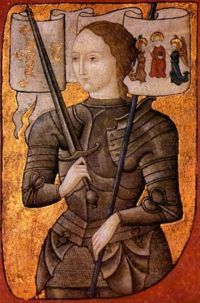Joan Of Arc
 From Conservapedia
From Conservapedia | Joan of Arc | |||
|---|---|---|---|
| |||
| Born | January 1412? Domremy, France | ||
| Died | May 30, 1431 Rouen, France | ||
Saint Joan of Arc (Jeanne d'Arc)[1] (Domremy in Champagne, France possibly 7th January 1412 - Rouen, France 30th May 1431) was a girl who, at the age of seventeen, believed she had been called by God to lead the French army which went on to defeat the English at the siege at Orleans in 1429. She was later captured by the English, burned at stake as a heretic in 1431, and was canonized by the Roman Catholic Church in 1920 and is accordingly known today as Saint Joan.
Saint Joan's prophecies were remarkable, ringing true both as to the predicted events and the timing of when they would occur. She predicted and accepted her own martyrdom, and also predicted that the English subsequently would fall when it did. Joan explained that she was guided by specific angels.[2]
At her trial, Saint Joan of Arc's skillful, probably inspired, handling of relentless cross-examination was admired by supporters and foes alike. For example, she responded to an attempt to entrap her in blasphemy as follows:[3]
- Question at Trial: “Do you know if you are in the grace of God?”
- Joan of Arc: “If I am not, may God place me there; if I am, may God so keep me. I should be the saddest in all the world if I knew that I were not in the grace of God. But if I were in a state of sin, do you think the Voice would come to me?”
Her story has inspired numerous works of art, notably George Bernard Shaw's 1923 play Saint Joan (considered one of his greatest plays) and Mark Twain's book Personal Recollections of Joan of Arc (which Mark Twain called "best and favorite work"). Both are sympathetic and admiring depictions. In contrast, in Shakespeare's play Henry VI, Part 1, the character "Joan La Pucelle" is depicted as she was generally viewed by the English at the time: as a witch and sorceress who was justly executed. Joan of Arc is also known as the Maid of Heaven, first used by author Ben D. Kennedy as the title for his epic poem about Joan of Arc, Maid of Heaven: The Story of Saint Joan of Arc, first published in 2007.
Contents
- 1 Background
- 2 Siege of Orleans and beyond
- 3 Capture, trial, and execution
- 4 Rehabilitation
- 5 Quotations
- 6 See also
- 7 References
- 8 External links
Background[edit]
Joan stepped onto the stage of world history during the Hundred Years' War with England at a point in time when French fortunes were at a low ebb. The English and their Burgundian allies had confined the faction of the uncrowned and disinherited King Charles VII (the Dauphin) to southwest France and had laid siege to Orleans, the fall of which would have permitted the English to invade Charles' remaining French territory.
Siege of Orleans and beyond[edit]

After a hazardous journey from her native Domremy through English held territory, Joan arrived at the court of the Dauphin in Chinon in early March 1429 bearing her message that God had sent her to aid the French cause by lifting the siege of Orleans and leading the Dauphin to Reims to be coronated. After an inquiry by Churchmen at Poitiers had found nothing of madness or heresy in her, she returned to Chinon and was sent with a French army to attempt to relieve the besieged town of Orleans.
Although the other French military leaders did not, at least at first, hold Joan in high regard, she managed to gain the loyalty of much of the soldiery and pursued, over the objections of the more cautious French commanders, a strategy of aggressively attacking the besiegers. The result was the lifting of the siege of Orleans in early May 1429 and, within the next month, the clearing of the remaining English held towns in the Loire River valley.
Following these spectacular military successes, Joan then led French forces northwards through English held territory to Reims where Charles was formally coronated.
Capture, trial, and execution[edit]
In the Spring of 1430, Joan was captured at the town of Compiegne while leading troops attempting to defend against an English siege. She was held for much of the remainder of that year by her Burgundian captors, but then was sold to the English after which she was transferred to Rouen where she was put on trial in proceedings governed by the Inquisition.[4]
After a preliminary inquiry, which was part of Inquisitorial proceedings, the actual trial began in February 1431, lasting some three months. Following this, after being threatened with immediate burning at the stake, Joan signed an abjuration, though there is considerable doubt that she knew what she was signing since she was illiterate and, in fact, another document may have been substituted for the one she signed. Shortly thereafter, in obedience to her voices, she recanted the abjuration. By the rules of the Inquisition, this made her a relapsed heretic and she was then burnt at the stake in Rouen's market square.
Rehabilitation[edit]
Joan's crucial intervention at Orleans had turned the tide in the Hundred Years' War, but she did not live to see the conclusion of that conflict. When the war finally ended, the French King, Charles VII, inaugurated the process of re-examination of Joan's life and career with an inquiry into the proceedings at Rouen. Soon thereafter, formal hearings were approved by the Pope. The resulting investigation, commonly referred to as the Trial of Rehabilitation (though it was not, strictly speaking, a trial, but rather an inquiry into the earlier Trial of Condemnation) took testimony of over a hundred witnesses and, in the end, set aside the original verdict of Rouen, declaring it to be "iniquitous, and full of lies".
Quotations[edit]

- "I place trust in God, my creator, in all things; I love Him with all my heart."
- "Gentle Dauphin, I am called Joan the Maid (Jehanne la Pucelle)"
- "In God's name, the soldiers will fight and He will grant victory."
- "I trust in my Judge, who is the King of Heaven and Earth".
See also[edit]
Burning at the stake, Biblical pretext for
References[edit]
- ↑ Joan of Arc is the English translation of the French name Jeanne d'Arc. Her name was spelled in a variety of ways; she herself signed her first name as "Jehanne" on some letters. Contemporary accounts of Joan of Arc, Bryn Mawr college library. She is also known as "the Maid of Orleans" and "La Pucelle" (French for "the maid").
- ↑ https://angels-angelology.com/joan-of-arc-and-the-angels
- ↑ https://www.biographyonline.net/women/joan-of-arc.html
- ↑ Years after the trial of condemnation, in testimony during the rehabilitation proceedings, Guillaume Manchon, the chief notary at the 1431 Trial, testified that in spite of pressures exerted upon him and his assistants to alter the court records to Joan's disadvantage, he and other witnesses maintained that record, including the Latin translation of Thomas de Courcelles, was a reliable account of what had happened at the Trial. As regards the official record of the trial, which, so far as the Latin version goes, seems to be preserved entire, we may probably trust its accuracy in all that relates to the questions asked and the answers returned by the prisoner. These answers are in every way favourable to Joan. Her simplicity, piety, and good sense appear at every turn, despite the attempts of the judges to confuse her. (http://www.newadvent.org/cathen/08409c.htm Joan of Arc)
External links[edit]
Web references
- Transcript of the Trial of Joan of Arc, translation of W.P. Barrett
- Nullification Trial of Joan of Arc, transcripts of testimony
- St. Joan of Arc Catholic Encyclopedia
- Saint Joan of Arc Center Albuquerque, N. M.
- MaidOfHeaven.com Dedicated to telling the true story about Saint Joan of Arc
- biography
Print literature
- Gies, Frances, Joan of Arc: the Legend and the Relaity, Harper and Row, New York (1981) ISBN 0-690-01942-4
- DeVries, Kelly, Joan of Arc: a Military Leader, Sutton Publishing, Gloucestershire, England (1999) ISBN 0-7509-1805-5
- Spotto, Donald, Joan: the Mysterious Life of the Heretic Who Necame a Saint, HarperSanFrancisco, (2007), ISBN 978-0-06-081517-2
- The Trial of Joan of Arc, translated and introduced by Daniel Hobbins, Harvard University Press, Cambridge, Massachusetts (2005) ISBN 0-674-02405-2
- Pernoud, Regine and Clin, Marie-Veronique, Joan of Arc: Her Story (revised and translated by Jeremy Duquesnay Adams and edited by Bonnie Wheeler), St. Martin's Press, New York (1998) ISBN 0-312-21442-1
Categories: [Military Commanders] [Saints] [French People] [Women] [French History] [Witchcraft]
↧ Download as ZWI file | Last modified: 03/15/2023 03:25:28 | 13 views
☰ Source: https://www.conservapedia.com/Joan_of_Arc | License: CC BY-SA 3.0
 ZWI signed:
ZWI signed:
 KSF
KSF